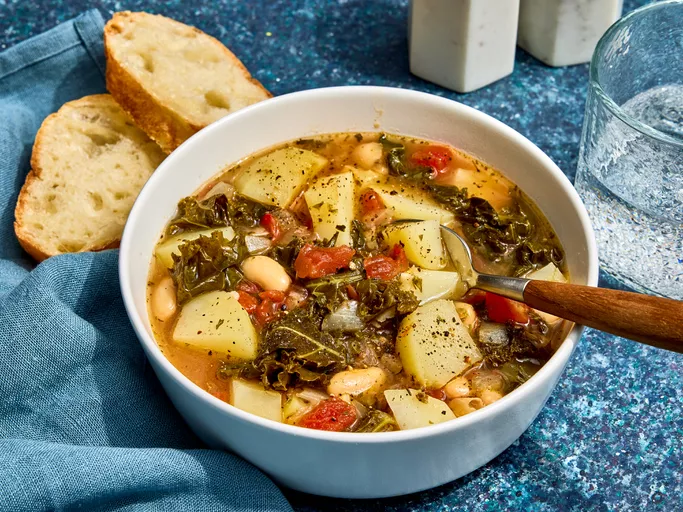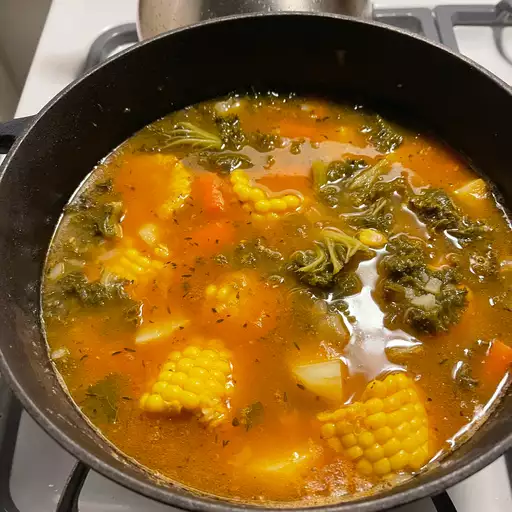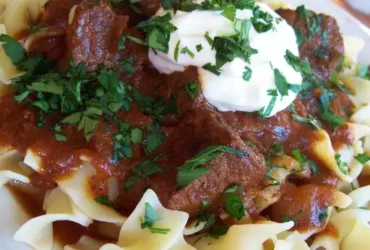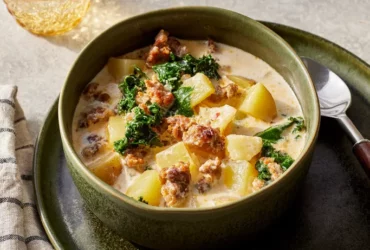Ingredients
Kale: Choose Curly-Leaf or Lacinato for Best Flavor
Kale: When it comes to choosing the best kale variety for your Kale Soup Recipe, you have several options, but two stand out from the rest: Curly-Leaf and Lacinato.
Curly-Leaf Kale is a popular choice due to its unique texture and flavor. The curly leaves add a delightful twist to your kale soup, making it a standout dish in any meal. It’s also relatively easy to find in most grocery stores, which makes it an excellent option for many home cooks.
Lacinato Kale, on the other hand, is known for its darker, more robust flavor. With a slightly bitter taste and a tender texture, Lacinato kale adds depth and complexity to your soup. Its rich, earthy flavor pairs well with a variety of ingredients, making it an excellent choice for those who want a more intense kale experience.
When choosing between Curly-Leaf and Lacinato, consider the overall flavor profile you’re aiming for in your kale soup. If you prefer a lighter, brighter taste, Curly-Leaf may be the better choice. However, if you want to add a bold, earthy flavor to your dish, Lacinato is an excellent option.
Remember, both varieties are nutrient-dense and packed with vitamins, making either option a healthy addition to your meal. By choosing the right kale variety for your recipe, you’ll be able to create a delicious and nutritious kale soup that’s sure to please even the pickiest eaters.
So, there you have it – Curly-Leaf and Lacinato: the two best kale varieties for your Kale Soup Recipe. Whether you’re a seasoned chef or a curious home cook, these options are sure to elevate your dish and leave your guests wanting more.
1 bunch of curlyleaf or lacinato kale, stems removed
The ingredients for a delicious and nutritious Kale Soup recipe are outlined below:
Main Ingredients
- 1 bunch of curly-leaf or lacinato kale, stems removed – This is the star of the show, providing a boost of vitamins A, C, and K, as well as minerals like calcium and iron.
Oils and Spices
- 2 tablespoons olive oil – This healthy fat adds flavor and creaminess to the soup without adding extra calories.
- 1 small onion, chopped – The sweetness of the onion balances out the bitterness of the kale, creating a harmonious flavor profile.
- 3 cloves garlic, minced – Garlic adds depth and a hint of pungency to the soup, making it more aromatic and inviting.
Liquids and Thickeners
- 4 cups vegetable broth – A low-sodium broth provides a rich and savory base for the soup, while allowing the kale to take center stage.
- 1 can (14.5 oz) diced tomatoes – The acidity of the tomatoes helps to break down the cell walls of the kale, making it easier to blend into a smooth consistency.
Seasonings and Garnishes
- 1 teaspoon dried thyme – This herb adds a slightly earthy and herbal note to the soup, complementing the bitterness of the kale.
- 1/2 teaspoon salt – Use this as needed to bring out the flavors in the soup without over-salting it.
- Fresh lemon wedges or juice (optional) – A squeeze of fresh lemon can brighten up the flavors and add a refreshing twist to the soup.
2 tablespoons olive oil
The kale soup recipe relies heavily on a combination of aromatic and flavorful ingredients to bring out the best in this nutritious green.
One of the primary ingredients that play a crucial role in the success of this recipe is olive oil. Olive oil serves as the foundation for sautéing onions and garlic, which are essential flavor components in many soups.
The use of olive oil not only adds flavor to the dish but also provides a rich texture that complements the delicate taste of kale.
In this particular recipe, 2 tablespoons of olive oil is sufficient for sautéing the aromatics and providing a subtle depth of flavor. However, you can adjust the amount according to your personal preference or dietary needs.
1 onion, chopped
The onion plays a crucial role in bringing flavor and depth to various dishes, including our Kale Soup Recipe. One of the essential components of this recipe is 1 onion, chopped.
To begin with, selecting the right type of onion for your needs is vital. For cooking purposes, most people prefer using either yellow or white onions. These are commonly found in supermarkets and offer a mild flavor that complements many dishes without overpowering them.
The process of chopping the onion involves several steps. It’s not just about cutting it into small pieces, but also ensuring that each piece is evenly sized to facilitate even cooking. To do this efficiently, peel and place the whole onion on a sturdy cutting board. Use a sharp knife to slice off the top portion of the onion, then make parallel cuts from one end of the onion towards you.
To further chop the onion into uniform pieces, cut along these lines without cutting too deeply – this will keep your fingers safe. Turn the onion and repeat the process until all parts are equally chopped. Your 1 onion, now in perfectly sized pieces, is ready for use.
This chopped onion will be cooked along with other ingredients to create a flavorful base for your Kale Soup Recipe. This preparation ensures that each spoonful has the rich taste and aroma you’re aiming for in this nutritious meal.
3 cloves garlic, minced
When it comes to adding flavor and depth to our delicious Kale Soup recipe, ingredients like minced garlic play a crucial role. In this case, we require three cloves of garlic, which are quite small, so let’s break down what that actually means.
A single clove of garlic is roughly the size of a small marble or an almond, and it’s typically divided into several smaller sections called “sections” or “segments.” So, when you’re working with three cloves of garlic, you’ll have about nine to 12 individual segments. To mince these segments means to cut them into even smaller pieces, usually around 1-2 mm in size.
There are a few different ways to mince garlic, but the most common method is using a chef’s knife or a paring knife. Simply place each segment on the cutting board and carefully chop it into tiny pieces until you have achieved the desired consistency.
If you’re using a food processor or blender, you can simply pulse the garlic cloves a few times to mince them quickly. However, be careful not to overprocess, as this can lead to a paste-like texture that may affect the flavor of your soup.
In our Kale Soup recipe, we use minced garlic to add a pungent and savory flavor to the broth. The key is to balance the amount of garlic with other ingredients so it doesn’t overpower the dish. In this case, three cloves provide just the right amount of depth without being overwhelming.
Instructions
Cook Kale and Aromatics in a Hearty Broth
To prepare a delicious and nutritious kale soup, start by gathering all the necessary ingredients. You will need:
- 2 tablespoons of olive oil
- 1 onion, diced
- 3 cloves of garlic, minced
- 1 large carrot, peeled and diced
- 2 celery stalks, diced
- 4 cups of kale leaves, stems removed and discarded, leaves chopped
- 4 cups of chicken or vegetable broth
- 1 teaspoon dried thyme
- 1/2 teaspoon salt
- 1/4 teaspoon black pepper
Next, heat the olive oil in a large pot over medium heat. Add the diced onion and cook until it is translucent, about 5 minutes.
Add the minced garlic and cook for another minute, stirring constantly to prevent burning.
Then, add the diced carrot and celery stalks to the pot, cooking for about 5 minutes or until they begin to soften.
After that, add the chopped kale leaves to the pot. You can use either curly-leaf or lacinato kale for this recipe, but keep in mind that lacinato kale may require a bit more cooking time due to its denser texture.
Add the chicken or vegetable broth to the pot, making sure that all of the vegetables are covered with liquid. Bring the mixture to a boil, then reduce the heat to low and let it simmer for 20-25 minutes, or until the kale is tender and the soup has reached your desired consistency.
Stir in the dried thyme, salt, and black pepper during the last 5 minutes of cooking. This will allow the flavors to meld together and intensify.
Taste the soup and adjust the seasoning as needed. You can also add other ingredients such as beans, potatoes, or diced meats if you prefer a heartier soup.
Finally, serve the kale soup hot, garnished with some chopped fresh herbs like parsley or thyme if desired. Enjoy!
In a large pot, heat the olive oil over medium heat
In order to begin preparing the delicious and nutritious Kale Soup Recipe, it is essential to start with the fundamental step of heating the olive oil in a large pot over medium heat.
The first action involves carefully placing the pot on the stovetop and adjusting the burner to the correct setting for medium heat. It’s crucial to ensure that the heat is not too high, as this can cause the oil to burn or smoke before it has a chance to properly heat up.
Once the burner has reached the desired temperature, it’s time to add the olive oil to the pot. The amount of oil required may vary depending on personal preference, but a general rule of thumb is to use enough oil to lightly coat the bottom of the pot.
The next step involves carefully pouring the olive oil into the preheated pot, taking care not to spill any oil onto the stovetop or surrounding areas. It’s worth noting that using a thermometer can help ensure that the oil has reached the ideal temperature for cooking, which is typically between 325°F and 375°F.
As the oil begins to heat up, it will start to release its aroma and become fragrant. This indicates that the oil is ready for the next step in the recipe, which involves adding the chopped onions and garlic to the pot.
The addition of these ingredients is a crucial part of the recipe, as they provide a rich and savory flavor that complements the kale perfectly. To ensure that the onions and garlic are cooked evenly, it’s essential to stir them occasionally while they’re heating up in the oil.
Add the chopped onion and cook until softened, about 5 minutes
The instructions for preparing the Kale Soup recipe involve a series of steps that ensure the ingredients are cooked to perfection and combined in harmony to create a delicious and nutritious dish.
The first step in making this soup is to sauté the chopped onion, which requires attention to detail and a gentle touch. To do this, heat a tablespoon of olive oil in a large pot over medium heat, allowing it to warm up for about 2 minutes before adding the chopped onion.
Once the pot has reached the desired temperature, add the chopped onion and cook until softened, about 5 minutes. This step is crucial as it allows the natural sweetness of the onions to be released, adding depth to the overall flavor profile of the soup.
After the onions have been cooked, you can proceed with the next steps, which involve adding the garlic, kale, chicken broth, and other ingredients. The key is to move at a steady pace, ensuring that each component is well-coordinated and harmonious.
The beauty of cooking lies in its ability to transform simple ingredients into something extraordinary. With patience, attention to detail, and a commitment to quality, even the most basic recipe can be elevated to new heights, as seen in the Kale Soup recipe.
Add the minced garlic and cook for an additional minute
To successfully prepare a delicious Kale Soup, it’s essential to follow precise instructions and understand the cooking process.
Critical Steps
Here are the key steps involved in creating an exceptional Kale Soup:
- Add the olive oil to a large pot over medium heat, allowing it to warm up for a minute or two.
- Mince three cloves of garlic using a garlic press or a sharp knife, and sauté them in the oil until they release their fragrance, approximately one minute.
Adding the Minced Garlic: When instructed to add minced garlic and cook for an additional minute, follow these steps:
- Mince the garlic cloves as previously described.
- Pour the minced garlic into the pot containing the olive oil over medium heat.
- Cook for an additional minute while stirring occasionally, ensuring the fragrance of the garlic is released and evenly distributed throughout the mixture.
Key Considerations
To achieve success with this Kale Soup recipe, consider the following factors:
- The quality of ingredients: Fresh and high-quality ingredients are crucial for a delicious and flavorful soup.
- Temperature control: Maintaining the correct temperature during cooking is vital to prevent burning or undercooking the ingredients.
- Adequate stirring: Regularly stir the mixture to ensure even heating, prevent scorching, and distribute flavors uniformly.
Conclusion
Following these instructions and understanding the cooking process will lead to a delightful Kale Soup that satisfies your taste buds. Remember to stay focused on the steps involved in this recipe to achieve success.
Blending and Seasoning
Add Chicken or Vegetable Broth and Blend to Desired Consistency
To blend and season the kale soup, start by removing it from heat and letting it cool slightly.
This will make it easier to handle and help prevent the formation of steam bubbles that can cause the soup to splash or overflow when you blend it.
Next, add a small amount of liquid to the blender with the cooled soup. You can use chicken or vegetable broth for added flavor and moisture.
The ratio of liquid to solids is important here – start with a 1:1 ratio, but be prepared to adjust as needed depending on how thick or thin you like your soup.
For example, if the soup seems too chunky, add a little more broth. If it’s too runny, add some more kale puree or simmered down soup base.
Now, blend the mixture on high speed until smooth and creamy.
You can stop the blender to scrape down the sides with a spatula as needed, but be careful not to over-blend – you want to maintain a bit of texture from the kale for added depth and interest in the soup.
Transfer the blended soup back into the pot or serve it hot, garnished with some chopped fresh herbs like parsley or chives if desired.
The key here is balance – you want enough broth to bring out the flavors of the kale without overpowering them. Experiment with different ratios and seasoning combinations to find your perfect cup of kale soup!
Pour in 4 cups of chicken or vegetable broth and bring the mixture to a simmer
To achieve the perfect balance of flavors in our Kale Soup Recipe, we need to focus on two crucial steps: blending and seasoning.
The act of blending is essential as it allows us to break down the kale leaves into a smooth consistency that’s both comforting and visually appealing. It’s during this process that we’ll combine the cooked kale with a portion of the broth to create a creamy texture that’s reminiscent of a traditional potato soup.
However, blending isn’t just about creating a uniform texture; it’s also an opportunity to extract the maximum amount of flavor from our ingredients. As we blend, the heat from the mixture helps to release the natural oils and essence of the kale, which then mingle with the other flavors in the broth, creating a rich and satisfying taste experience.
When it comes to seasoning, the possibilities are endless! With a Kale Soup Recipe that’s already packed with nutrients and flavor, we can experiment with a range of herbs and spices to create a truly unique taste profile. From the earthy warmth of black pepper to the bright, citrusy zing of lemon juice, the options for customization are limited only by our imagination.
For this particular recipe, we recommend starting with a basic blend of salt, pepper, and nutmeg – classic seasoning combinations that complement the natural sweetness of the kale. However, feel free to get creative and add your own favorite spices or herbs to give the soup an extra boost of flavor!
To pour in 4 cups of chicken or vegetable broth, follow these simple steps: Carefully pour the broth over the blended kale mixture in a large pot or Dutch oven. The heat from the stove will gently warm the broth as it comes together with the other ingredients.
Reduce heat and let cook for 1015 minutes or until kale is tender
The art of blending and seasoning lies at the heart of creating a truly exceptional Kale Soup. It’s a delicate balance of flavors that requires attention to detail, but don’t worry, we’re here to guide you through it.
Blending
After your kale has wilted down, it’s time to blend the soup to your desired consistency. Here are some tips to achieve the perfect blend:
- Use an immersion blender or transfer the soup to a blender in batches, being careful not to splash any of the hot liquid.
- Blend until smooth, but still retain some texture if you prefer a chunkier consistency.
- If using an immersion blender, blend in small increments and scrape down the sides of the pot as needed.
Seasoning
Now that your soup is blended to perfection, it’s time to season with love. Here are some suggestions for adding depth and complexity to your Kale Soup:
- Add a pinch of salt to bring out the natural flavors of the kale and vegetables.
- Grind in some black pepper to add a subtle kick.
- Use lemon juice or vinegar to brighten the flavors and balance the richness of the soup.
Tips for Perfectly Cooked Kale
We mentioned earlier that you should reduce heat and let cook for 10-15 minutes or until kale is tender. Here are some additional tips to ensure your kale is cooked just right:
- Check the kale regularly while it’s cooking, stirring occasionally to prevent burning.
- If using curly kale, you may need to cook it for a bit longer than other types of kale.
With these tips and techniques, you’ll be well on your way to creating a truly exceptional Kale Soup that’s sure to please even the pickiest eaters!
Use an immersion blender to puree the soup to your desired consistency
To achieve the perfect blend of flavors, blending and seasoning are crucial steps in preparing a delicious kale soup. In this process, it’s essential to understand the role of both steps to get the desired outcome.
Blending refers to the act of breaking down or pureeing ingredients together to create a smooth texture. This step is particularly important when working with leafy greens like kale. Immersion blenders are ideal tools for this task as they allow for seamless blending within the pot, preventing any mess and saving time.
When using an immersion blender, it’s essential to puree the soup to your desired consistency. Some people prefer a smooth texture, while others enjoy a bit of chunkiness from the kale leaves. The beauty of using an immersion blender lies in its ability to achieve both textures with ease.
The seasoning step involves adding flavor enhancers to balance out the taste of the soup. In the case of a kale soup recipe, it’s common to use ingredients like garlic, onion, and lemon juice to add depth and brightness to the dish. Other seasonings such as salt, pepper, and nutmeg may also be used to enhance the overall flavor profile.
The key to seasoning a kale soup is to taste and adjust as you go along. This ensures that the flavors are well-balanced and not overpowering. It’s also essential to consider personal preferences when it comes to seasoning, as some people may have different tolerance levels for certain flavors.
Another critical aspect of seasoning is using high-quality ingredients. Fresh herbs like kale, garlic, and onion can make a significant difference in the overall flavor of the soup. The freshness of these ingredients will directly impact the taste and aroma of the final product.
In addition to using fresh ingredients, it’s also essential to consider the cooking time for each component. For example, kale typically takes longer to cook than other vegetables, so it’s crucial to adjust the cooking time accordingly to avoid overcooking or undercooking the dish.
Ultimately, blending and seasoning are interdependent steps in preparing a delicious kale soup. By combining these two elements effectively, you can create a harmonious balance of flavors that will leave your taste buds satisfied. Experiment with different ingredients and techniques to find your perfect blend, and don’t be afraid to adjust the seasoning as needed to suit your personal preferences.
By following these guidelines, you’ll be well on your way to crafting a kale soup recipe that is both delicious and memorable. Whether you’re a seasoned chef or a culinary novice, blending and seasoning are essential skills to master when it comes to creating mouth-watering soups like this one.
- Best Datanyze Alternatives for 2025 - April 24, 2025
- Best Hunter.io Alternatives for 2025 - April 22, 2025
- Best Lead411 Alternatives for 2025 - April 22, 2025















